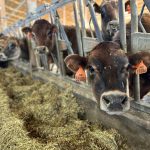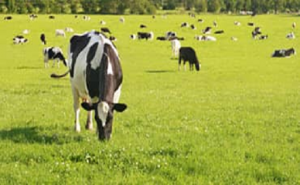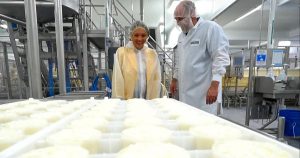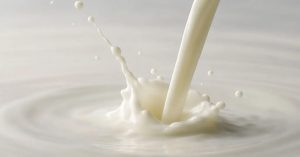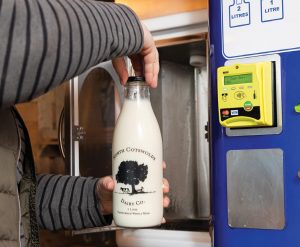
Dairy Outlook: Economist Corey Geiger discusses the industry’s challenges, including avian flu, labor issues and tariffs, while highlighting positive trends in retail sales and exports.
Dairy continues to face multiple challenges, according to Corey Geiger, lead dairy economist for CoBank.
“In recent weeks, several national news outlets have called to discuss what I refer to as ‘dairy’s difficult trifecta,’” Geiger says. “This includes highly pathogenic avian influenza and its effect on cow health, human health and milk production; immigration and its impact on labor; and of course, tariffs and the changes to trade. The latter topic on tariffs is challenging to discuss as the narrative changes by the day, hour, and even the minute.”
Geiger notes it is important to point out that dairy has many positive economic storylines.
“For starters, dairy grew into a record $76 billion retail category this past year, topping all other food categories, based on Circana U.S. sales data,” he says. “In addition to this positive trend, the average American now consumes 661 pounds of dairy products each year.” That’s the highest total dating back to 1959, according to USDA data.
Building on these two very important tailwinds, the U.S. exported $8.2 billion in dairy products and ingredients to customers around the globe last year. This made 2024 the second-highest export year in U.S. history, next to the $9.6 billion in products sold in 2022, Geiger says.
“Near term, trade may be the most important economic headwind,” he says. “That’s because U.S. dairy producers, via collaboration with dairy processors, now export 16% to 17% of the nation’s milk production to customers around the world.”
If dairy trade stalls, U.S. consumers cannot absorb all the milk component production and resulting dairy products, Geiger explains. “While new tariffs were paused in mid-April for 90 days with most countries, the issue still looms large. This holds true for U.S. and China trade, as tariffs stand at 145% [at the time of this writing] between the world’s two largest economies. This matters for dairy, as China is the world’s largest dairy product importer.”
Once a nonplayer
While volatility and uncertainty have prevailed in 2025, there is some certainty that can be celebrated, Geiger notes.
“The U.S. was essentially a nonplayer on the global dairy scene when the U.S. Dairy Export Council was founded in 1995, and the North American Free Trade Agreement was in its infancy,” he explains. “Back in those days, the U.S. exported about 2% to 3% of its milk production largely via surplus nonfat dry milk inventories. In those days, the U.S. was not a consistent supplier of dairy products to international customers.
“During the next 30 years, the U.S. grew its milk production from 155 billion to 226 billion pounds for a 45% growth rate. Even with those growing milk supplies, the U.S. managed to grow its export volumes to 16% to 17% of its milk production. That’s a rather impressive feat.”
There’s more room for optimism. Despite the current volatility, domestic and international dairy processors believe the U.S. is the place to be for dairy. That’s highlighted by the fact that there is a historic $8.5 billion of plant investment taking place in the U.S. in all product categories, including fluid milk, yogurt, ice cream, cheese, whey and butter. No other region of the world is experiencing this type of historic investment, Geiger says.
Where does the U.S. currently stand when it comes to dairy trade?
“The European Union group of 27 countries is collectively the world’s largest dairy product exporter,” Geiger says. “While it will be a strong player on the international stage, the region’s milk production has stalled from 2020 to 2024, largely because of self-imposed regulations related to carbon and methane production.”
Meanwhile, New Zealand is the world’s second-largest dairy product and ingredient exporter.
“This is particularly impressive given that the island nation has roughly the same land space as Wisconsin and Illinois,” Geiger says. “Its 5 million dairy cows are a mighty force that are responsible for 35% of New Zealand’s exports. Yes, over one-third of Kiwi exports come from dairy, and the country’s biggest dairy trading partner is China. All this noted, the island nation is land-bound, so it will be difficult to substantially grow its milk production.”
Grown into a contender
The U.S. has grown to become the world’s third-largest dairy product exporter. The U.S. is also the world’s largest cheese producer. In 2024, the U.S. exported $8.2 billion in dairy products, with Mexico purchasing just over 25% of that that total, according to Geiger.
The U.S. also imports $5.4 billion in dairy products, with 56% coming from five countries: Ireland, $908 million; New Zealand, $765 million; Italy, $568 million; Canada, $418 million; and France, $396 million.
“Ireland’s leading product is butter, and cheese tops the list from Italy and France. New Zealand sends butter and whey our way, and Canada is largely finished dairy products processed in that country from U.S. milk,” Geiger explains.
As for U.S. dairy exports, Mexico, China and Canada collectively account for just over 50% of all U.S. dairy trade. Next on the list are South Korea and Japan. With 125% tariffs in place on U.S. goods bound for China, it is more imperative than ever to maintain and grow trade with Mexico, Canada and other trading partners in Central America, South America, Southeast Asia, and the Middle East and North Africa region.
One saving grace that could support dairy trade between the U.S. and China could be sweet whey powder and whey permeate exports, Geiger notes.
“Hogs are an important source of human nutrition in China,” Geiger says. “To combat African swine fever, China banned feeding food waste and animal byproducts to the swine herd nearly a decade ago because that was a major disease transmission vector. As a result, about 40% of U.S. whey exports are sent to China these days as a major feed source for hogs. Until the recent tariff escalation, China had exempted these whey products from tariffs. The question looms, will those exemptions remain in place?”
When it comes to the rest of the world, U.S. dairy trade also could slow some due to tariffs. On the flip side, U.S. butter and cheese prices are quite a bit lower than the two major players.
In mid-April, U.S. cheddar sold for $1.70 per pound compared to EU and Oceania cheddar at $2.30 per pound. Butter also had a similar spread, priced at $2.30 per pound in the U.S. compared to butter from the EU and New Zealand trading at over $1 per pound higher, Geiger says.
“Given the lower price points, U.S. dairy trade should keep flowing despite the tariffs,” he says. “Should that happen, domestic inventories should remain in balance, and that would support dairy product prices. Whey has been slightly a different story, with the U.S. leading in world prices. Lost sales in these categories could be a harbinger of slower markets. This is a situation that needs careful monitoring in the days, weeks, and months ahead.”
You can now read the most important #news on #eDairyNews #Whatsapp channels!!!
🇺🇸 eDairy News INGLÊS: https://whatsapp.com/channel/0029VaKsjzGDTkJyIN6hcP1K

